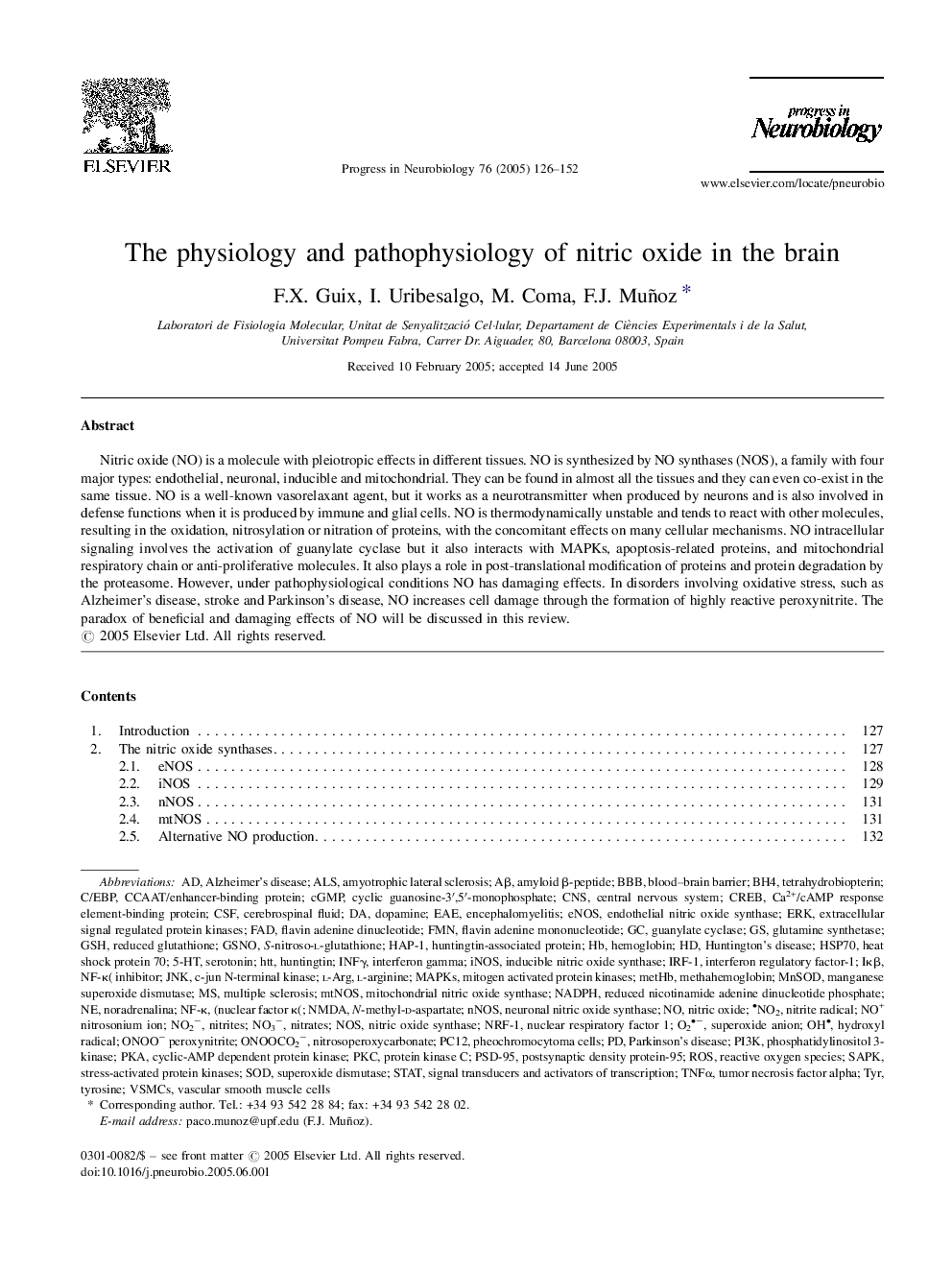| Article ID | Journal | Published Year | Pages | File Type |
|---|---|---|---|---|
| 9435156 | Progress in Neurobiology | 2005 | 27 Pages |
Abstract
Nitric oxide (NO) is a molecule with pleiotropic effects in different tissues. NO is synthesized by NO synthases (NOS), a family with four major types: endothelial, neuronal, inducible and mitochondrial. They can be found in almost all the tissues and they can even co-exist in the same tissue. NO is a well-known vasorelaxant agent, but it works as a neurotransmitter when produced by neurons and is also involved in defense functions when it is produced by immune and glial cells. NO is thermodynamically unstable and tends to react with other molecules, resulting in the oxidation, nitrosylation or nitration of proteins, with the concomitant effects on many cellular mechanisms. NO intracellular signaling involves the activation of guanylate cyclase but it also interacts with MAPKs, apoptosis-related proteins, and mitochondrial respiratory chain or anti-proliferative molecules. It also plays a role in post-translational modification of proteins and protein degradation by the proteasome. However, under pathophysiological conditions NO has damaging effects. In disorders involving oxidative stress, such as Alzheimer's disease, stroke and Parkinson's disease, NO increases cell damage through the formation of highly reactive peroxynitrite. The paradox of beneficial and damaging effects of NO will be discussed in this review.
Keywords
CREBPI3K5-HTTNFαJnkflavin adenine dinucleotideFMNNADPHGSHAβcGMPERKNOSiNOShsp70eNOSpKaEAENMDAN-methyl-d-aspartatePSD-95nNOSMnSODPKCINFγNRF-1GSNOBH4tetrahydrobiopterinhttPC12NF-κVSMCsguanylate cyclaseIRF-1SAPKextracellular signal regulated protein kinasesmtNOSC/EBPc-Jun N-terminal kinaseMAPKsMitogen activated protein kinasesNO2−NO3−O2−ROSamyloid β-peptidel-arginineSTATencephalomyelitissuperoxide anionamyotrophic lateral sclerosisl-ArgFADAlzheimer's diseaseALSHuntington's diseaseParkinson's diseasetumor necrosis factor alphaTyrTyrosineCNSDopamineHydroxyl radicalSODBBBBlood–brain barrierSerotoninVascular smooth muscle cellspheochromocytoma cellsinducible nitric oxide synthaseendothelial nitric oxide synthaseneuronal nitric oxide synthasemanganese superoxide dismutaseSuperoxide dismutaseMitochondrial nitric oxide synthasecentral nervous systemNuclear respiratory factor 1interferon regulatory factor-1Phosphatidylinositol 3-kinaseCerebrospinal fluidCSFsignal transducers and activators of transcriptionmetHbMultiple sclerosisNoradrenalinaNitratesnitrosoperoxycarbonateNO2NitritesNitric oxidenitric oxide synthaseHuntingtinHemoglobinCCAAT/enhancer-binding proteinheat shock protein 70postsynaptic density protein-95Protein kinase Creduced nicotinamide adenine dinucleotide phosphatereduced glutathionestress-activated protein kinasesInterferon gammaGlutamine synthetasecyclic guanosine-3′,5′-monophosphateReactive oxygen species
Related Topics
Life Sciences
Neuroscience
Neuroscience (General)
Authors
F.X. Guix, I. Uribesalgo, M. Coma, F.J. Muñoz,
